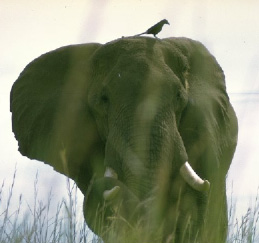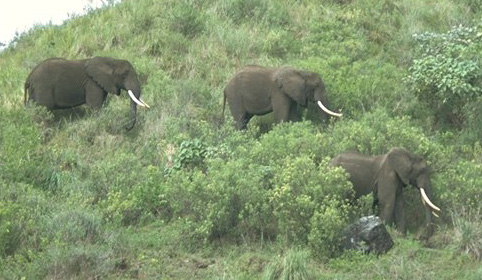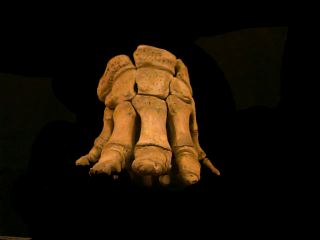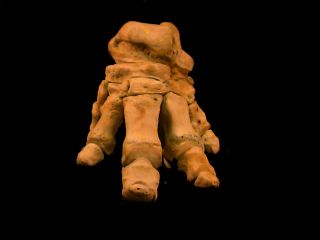ORDER PROBOSCIDEA:
ELEPHANTS
Two extant species:
Loxodonta africana - the
African elephant.
Elephas maximus - the
Indian elephant.
Proboscids were once found across most of the globe.
Many extinct elephants shared the typical features as the surviving
types. Until the end of the last ice age there were a further 6
elephant species, including the mastodon
Cuvieronius, which was
driven to extinction perhaps within the last 2,000 years.
The large size of proboscids probably evolved in
response to competition with the perissodactyls (also hind-gut
fermenters)
|

|
|
An African elephant
(Loxodonta
africana).
|
ELEPHANT TEETH
Aside from the tusks (modified second incisors) there
are only three molars and three milk pre-molars. Uniquely, in the
elephants only four of these are exposed at once (one per half jaw).
Each will be replaced throughout life by five others, being pushed
forward as they become worn down.
The teeth are very hypsodont (ridged), especially the
later teeth. The grinding surface consists of enamel, dentine and
cement. These wear at different rates so the surface is never worn
smooth.
|
|
|
XH15-3.1:
Loxodonta
africana skull
|
The skull of this juvenile African elephant shows
features typical of the elephants and mammoths which became extinct
so recently. The skull is very 'solid' and heavy. Both jaws are deep
to accomodate the huge teeth. They are also very short for such a
large animal. The nasal opening is mounted high on the forehead and
shows where the trunk (a grossly elongated, prehensile upper lip and
nose) terminates at the skull.
The trunk is used for smelling, touching, as a
snorkel when submerged, to drink, squirt water & greet other
elephants.
 |
|
Some African elephants do not live on the
savannah but in the forests of Africa. It was from here that
Loxodonta
spread onto the plains after the other elephant genus,
Elephas,
became extinct in Africa. Forest elephants are a separate
subspecies.
|
Elephas maximus
feet.
 |
|
XH15-2.2
Elephas maximus fore foot.
|
Both the fore-foot (XH15-2.2) and the hind-foot
(XH15-2.3) of the Indian elephant are five toed. These feet must
support an enormous weight, and so there has been no reduction in the
number of digits. Instead, the foot is broad, and rests on a pad of
fatty tissue and fibres (see diagram). The hooves are nail-like (as
can be seen on the dried hind foot - XH15-2.1). Although the legs are
strong and pillar-like (with a long humerus and femur but short
distal segments) to support the elephant's weight, it can charge at
25mph for short bursts.
 |
|
XH15-2.3 Elephas
maximus hind foot.
|
TUSKS
Tusks are used for digging, scraping and as weapons.
They grow continuously, from their appearance at 2 years until death,
reaching 3.5 metres in
Loxodonta bulls. Such
large bulls have become rare as a consequence of ivory poaching, a
trade which threatens all elephants more even than habitat
destruction.
| 